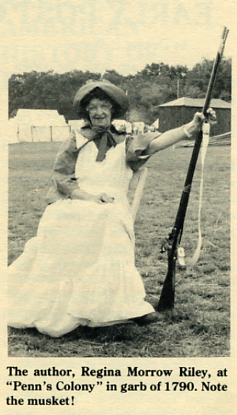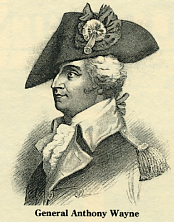
Click Here to Return to Milestones

The 1790's were a trying and turbulent time period in American history. Our young nation was attempting to establish itself in the world market and our economy was shaky at best. Britain had not abandoned a string of forts along the Great Lakes according to the Treaty of Paris, signed in 1783. British forces and agents of the government were inciting the native populace to rebel against westward expansion and settlement. As raids and deaths increased, the citizens on the frontier demanded protection from the American government. The stage had been set for the biggest crisis of the Washington administration.
In 1790, the only military entity that existed was the 1st American Regiment. This token army, thrown together by a government that was against standing armies and deep in debt, was responsible for guarding the entire frontier. It was plagued with supply problems, poor equipment and shoddy leadership. President Washington, over estimatating the ability of this army, and underestimating the military capability of the Native Americans, sent this army to quell the rebellion. Colonel Josiah Harmar and his army arrived in the heart of the Miami country (north-central Ohio) ready to do battle. Harmar split his forces and was promptly attacked by the brilliant strategist, Chief Little Turtle. In short order, both of Hamar's command elements were attacked and suffered serious casualties. Humiliated in defeat, the army fled back to Fort Washington in Cincinnati. A serious blow had been dealt to the American army, but the worst was yet to come.
The following year, another punitive expedition was initiated. General Arthur St. Clair was chosen to command this expedition. Another badly supplied, poorly trained and motivated army headed to fight the powerful and ably led Miami Indians. On November 3,1791, St. Clair encamped along the Wabash River. During the night his forces were surrounded by Little Turtle's warriors. At dawn, Little Turtle attacked in a classic halfmoon formation. Arthur St. Clair's forces were annihilated in what is today the worst military defeat of the United States Army by the Native Americans. General St. Clair survived, but the casualties were appalling. Over 690 men and women were killed, including 39 line officers. Majorgeneral Richard Butler was one of the casualties. To put this in perspective, imagine a battle in which we lost over half of the Marine Corps in one day.
This defeat demoralized and weakened the American government, which apparently could not even protect its citizens. The British and Native Americans were emboldened by this strategic victory. Washington was livid and had St. Clair courtmartialed. What could he do now? Why did we lose so badly? Secretaryof-war, Henry Knox had the answer. We needed a standing army of professional soldiers because we obviously needed men who were well trained, well supplied and motivated. On March 5, 1792, the United States Militia Act was passed in Congress. This act essentially rebuilt the army and replaced the voids left by dead officers and men. The army was designated the Legion of the United States. After a long and troublesome contemplation of whom to elect Commanderin-Chief, Washington chose "Mad" Anthony Wayne.
During the Revolution, Wayne was always in the thick of the fight. His famous statement, "Issue the order, Sir, and I will Storm Hell," when asked to assault Stony Point, speaks volumes about the man. Stony Point was captured in a bayonet assault on a British stronghold. Wayne was shot in the head and continued with the attack. After accepting command, Wayne went to Fort LaFayette in Pittsburgh and assembled his troops as recruiting continued. When the army grew too large for the small city, he sent an expedition down the Ohio. Near the long abandoned Indian village of Chinengue (Logstown) Wayne spotted the ideal location for an impregnable fortress. What would someday become Beaver County would soon insert its page in our Nation's military history.
On November 9, 1792, over 200 men arrived and began to lay out this fortification. On November 28, 1792 , the main army of 2,500 men arrived in the camp that Wayne himself dubbed Legion Ville. Huts of the soldiers were to be completed prior to the officers' quarters. The arduous task of building and fortifying the area continued well into December. By January, the officers' huts, stables, barracks and Wayne's headquarters were completed. Four large 50' x 50' redoubts were built on the four corners of the camp. When everything had been built, Wayne began to intensely train the new recruits. To instill "Espirit de Corps", Wayne ordered that distinct colors represented each Sub-Legion. The 1st Sub-Legion's colors were to be black and white; the 2nd Sub-Legion was red and white; the 3rd Sub-Legion was black and yellow, and the 4th Sub-Legion was green and white. The elegant uniform was blue, piped in red and had the 11 new" style high collar. To top off the uniform, a stiff black leather stock was to be worn around the neck.
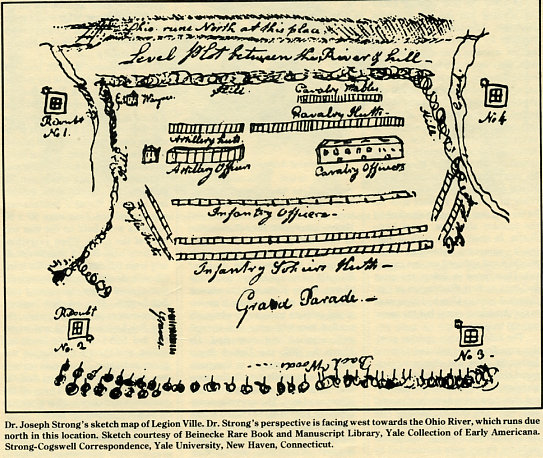
Washington said to spare no expense in powder and ball to make these men soldiers. Ten hours a day, the infantry marched, wheeled and drilled. Wayne was specially fond of the bayonet and many were the hour that the men charged unseen targets at the double-quick.
At night over 210 men surrounded the perimeter in defensive positions. When a man got off duty, he fired his weapon at assigned targets. Marksmanship was stressed, with rewards given to the best shots. The rifle battalions, who carried the Pennsylvania Long-rifle, forfeited their reward whenever they were beaten by the infantry, who carried smoothbore weapons. Captain Robert Mis Campbell was put in charge of the dragoons (cavalry) and built a training field where Levinson Steel now stands. Campbell's dragoons were taught to fight from horseback, dismounted and to ride like the wind. They were taught to rely on the heavy saber and to jump obstacles at a gallop. The artillerymen were taught the essential elements of ballistics. They fired their Howitzers day-and-night, until their officers felt they were proficient. The regime at Legion Ville was brutal by today's standards. Up to 15 courtmartials took place each day. Punishment ranged from branding, whipping, or running the gauntlet to public humiliation. Wayne would not repeat Harmar and St. Clair's mistakes. He was under orders from The President of the United States to succeed and he did what he felt necessary to complete his mission.
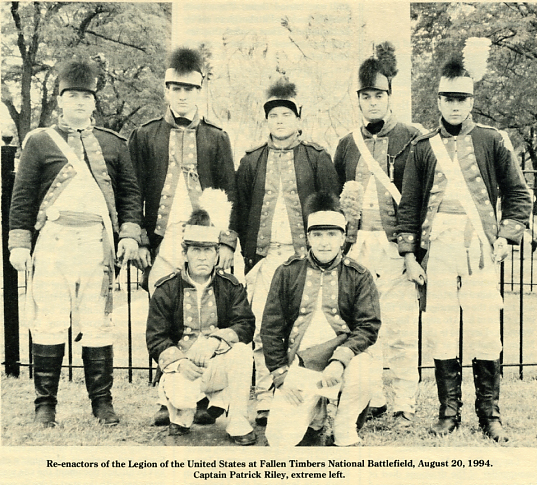
Wayne's ultimate success would hinge totally on the discipline and training of his men. Despite the rigid training regime of the "Old Mogul" as his men called him, the troops respected and admired Wayne. He made sure they were clothed, fed and paid promptly. Slowly, but surely, the Legion became hardened and professional. In March, a reporter from Pittsburgh noted that he had never seen such good shots as the soldiers, nor had he seen men so proficient with artillery and horsemanship. He noted that in marching and drilling, none would ever excel these troops. He said that they moved, turned and charged as one man. He was quite impressed.
Wayne himself was proud of these men. In a letter to Wayne, Knox said, "I hope the public may hereafter recollect with great satisfaction that Legion Ville was the School of Discipline of the American Legion." By April, the army was judged ready by Wayne. He publicly stated that he had never seen better troops, even during the Revolution. On April 30, 1793, the Legion headed into the Ohio Country and began the campaign. After building a chain of forts to supply his army, Wayne had arrived in the heart of the Miami Country (near Toledo, Ohio) in August of 1794. On the 20th, Wayne's forces decisively defeated the Native Americans and British at the Battle of Fallen Timbers. The discipline of the Legion was the deciding factor in the victory. When asked to charge into fallen brush and timber, the Legion obeyed as one and charged.
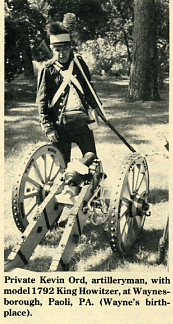
Captain Robert Mis Campbell, the commander of the dragoons died in the first charge. This battle redeemed American arms and struck a blow to the British and Indians. The discipline and training that these men had in a distant place called Legion Ville, carried the day. In 1795, the Treaty of Greene Ville was signed. This treaty brought peace and opened the Northwest Territory to settlement. In 1796, the victorious Legion of the United States accepted formal surrender of all British posts in the United States. This event was really the true end of the American Revolution. American sovereignty was now absolute. On December 15, 1796, Commander-in-Chief, Major-general Anthony Wayne died in the Erie blockhouse and was buried there. Wayne was heading back to Pittsburgh to set up headquarters. Thus ended this fascinating period in our county's history.
Legion Ville played a major role in this campaign and the modern United States Army and Marine Corps owes much to this small army. The 3rd United States Infantry (The Old Guard) who guard the Tomb of the Unknown Soldier, descended from the 1st Sub-Legion. The badge of the Old Guard shows a black cocked-hat with a white plume, the colors given to the 1st Sub-Legion by Wayne. In 1796, when the rifle-battations of Wayne's Legion were abandoned, the uniforms were put into storage. In 1798, when the United States Marine Corps was officially designated a distinct branch of the military, they were given Wayne's surplus uniforms. The distinctive dress uniform of the Marines with its high collar and red piping is very similar to the Legion's uniform. It is said that the term "leatherneck" came from the neckstock the soldiers were forced to wear. Henry Burbek, who designed the layout of Legion Ville was a co-founder of West Point Military Academy. Other notables at Legion Ville were William Henry Harrison, ninth president of the United States; Zebulon Pike, who discovered Pike's Peak; William Eaton, who led the Marines ashore at Tripoli and Meriwether Lewis and William Clark, the leaders of the Lewis and Clark expedition. This tiny piece of land in Beaver County is uniquely tied to American history.
The Legion Ville site was abandoned intact. Virtually every traveler down the Ohio mentions the "old camp of General Wayne...," in their journals. Colorful descriptions and stories can be found in many Western Pennsylvania history books. Immediately prior to the First World War, a concerted effort to preserve the site was undertaken. The outbreak of hostilities in Europe focused attention elsewhere and the effort faded. After the war ended, a group of soldiers got together to form an organization of veterans. One of these men was from Sewickley and his name was Eric Fisher Wood. Wood was very good friends with Robert McKnight, a Sewickley historian and one of the men who documented the Legion Ville site in 1939.
McKnight was a local expert of the American Legion (Wayne's army). Enter another player, Theodore Roosevelt. Roosevelt had written an article on the American Legion in the 1890's, and was an ardent admirer of General Wayne. As a matter-of-fact, he had called Wayne the "father of the United States Army," in his article. It was Theodore Roosevelt who held the dinner for the veterans who were forming this new organization. Current research gets our historical society closer and closer to making a concrete connection between the modern organization and the American Legion. We honestly think there is a very real connection between the Legion and Wayne's army. What better way to honor the American army of old. Roosevelt most assuredly would have suggested the name if he had any influence on the first meeting. Further research should prove or disprove our theory. In 1939 Robert McKnight wrote an article describing the site and mentions that much remained intact. The 1938 aerials from the National Archives show intact earthworks and a redoubt. McKnight's effort to further document the site was quenched with the start of the Second World War. Isn't it ironic that this site which played such a large role in another war, would still play a role in World War 11. Trailers were built there for workers in the adjacent steel mills.
It was not until the 1970's that another Herculean effort to save the site was undertaken and the Anthony Wayne Historical Society was formed. Between in-fighting with another organization which still claims the birthplace of the United States Army and an apathetic President, this effort was again shot down. After passing the Senate unanimously, Senate Bill 1104 was pocket-vetoed by President Carter. This was a huge let down to the society and they spent many years regrouping.
In 1989, Patrick Riley became involved in the preservation and was elected president of this historical society. In an effort to focus effort on Legion Ville, the society was renamed the Legion Ville Historical Society in 1992. His masters thesis was on the Legion Ville site and was completed in 1993. Our effort has been to preserve this important cultural resource for not only Beaver County, but for the nation as well.
It has been an astonishing journey to preserve this place. Old attitudes prevail in this valley and nobody quite seems to know what to do with a historical resource. The Beaver County Corporation for Economic Development even wanted to build an industrial park at the site several years ago. During recent archaeological excavations conducted on the site from 1991-1994, significant features of Wayne's camp have been found. These include firepits, chimney foundations, floor sills and even wagon tracks. Hundreds of historic and prehistoric artifacts have been uncovered. A trace of the Old Beaver Road is virtually intact. This road is at least 5,000 years old and was a well-known Indian trail in the distant past.
Our efforts to save this site have been serious and many organizations want to help. The National Trust for Historic Preservation is very interested in saving this site. The major hurdles in this effort are the local commissioners, who do not all agree on the site's preservation. This has been a hurdle that cannot be jumped. We have done our part to preserve the history of this unique site. From California to Ireland, the history of this place is known. Thanks to the efforts of a patriotic group of people in this county, Legion Ville has appeared in many recent history books. Efforts to save the Fallen Timbers National Battlefield have been aided by our public awareness campaign with Legion Ville.
It remains to be seen what will happen to Legion Ville. It is obvious that many people in this county simply do not know what to do with a cultural resource. We have what is arguably the best preserved Federal Era site in North America. What we do to this site will be a testimony to who we are and what we are all about. We have done our part in bringing the history back to life. Ten years from now, I do not know what will be at Legion Ville. My guess is that it will not be a historic site. My guess is that something will be built there and the graves desecrated. Whatever is there will be a testimony to what is really important to Beaver County. As we all argue over who is going to hold the fire hose, will we all watch the house burn down? The choice has to be made.
